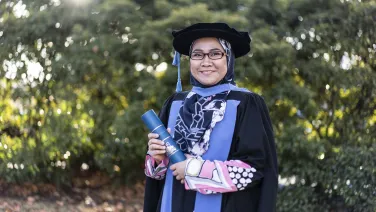Gravitational Waves - the find of a millenium
It was one of the most violent events in the Universe, when two black holes collided 1.3 billion years ago; but completely invisible.
Thanks to an amazing team of physicists, we captured it, but not with a telescope. The tiny ripples in spacetime from the collision reached Earth in 2015 and moved the twin gravitational wave detectors of the Laser Interferometer Gravitational-wave Observatory (LIGO) a fraction of the radius of a proton. That was enough to open a new epoch of exploration into the dark universe – black holes, dark matter and gravity.
ANU led the Australian contribution to LIGO.
"This observation confirms that gravitational waves do exist. It is a moment that will be remembered for a thousand years," said Professor David McClelland, Director of the ANU Centre for Gravitational Physics in the ANU.
Thirteen ANU scientists were part of a global scientific collaboration that proved the existence of gravitational waves for the first time, 100 years after their existence was predicted by Albert Einstein in his Theory of General Relativity
PhD student Georgia Mansell is one of the ANU team, who, along with over 1000 other scientists around the world have shared in some of physics’ most prestigious prizes following the discovery.
“It was incredible to be involved with such a momentous discovery in science,” she said.
“I’m really excited to see what other gravitational wave sources LIGO detects.”
Ms Mansell is working on a quantum optics technique called squeezing that will soon be installed at LIGO and allow it to see further out into the dark universe.
During her PhD she travelled to LIGO in the northwest of United States.
“It’s impressive: the electronics have a dedicated room, as does the laser. The vacuum tanks are massive towers,” Ms Mansell said.
“You can climb over or under some beam tubes, it feels like a playground for physicists!”
As well as the squeezing system ANU was responsible for a system that stabilises and locks the laser and mirrors to each other at the start of experiments. The system also pulls the interferometer back into line if it is disturbed, for example by earthquakes anywhere in the world.
ANU also built, installed and commissioned 30 small optics steering mirrors for routing the signal beam around the interferometer and into the detectors.
As well experimental apparatus, ANU researchers searched LIGO data for gravitational waves from young supernova remnants and worked with the University's SkyMapper telescope to look for flashes of light associated with the first observation of gravitational waves.
Professor Daniel Shaddock believes physicists can be useful. Although people might think his research area, searching for gravitational waves formed when black holes collide, might not have much practical consequence for society, he has proven it is useful.
All kinds of high technology areas are benefiting from his company, Liquid Instruments, which has launched a revolutionary multipurpose measurement tool. He is also working in the Space Environment Research Centre using high powered lasers to divert spacejunk on collision course with multibillion dollar satellites.
“The gravitational wave detectors are such amazing cutting-edge technology – they have real potential for society and to be translated into commercial opportunities,” he says.
His students have turned out to be useful, too, heading off to companies such as Apple, NASA, or building satellites with Lockheed Martin.


